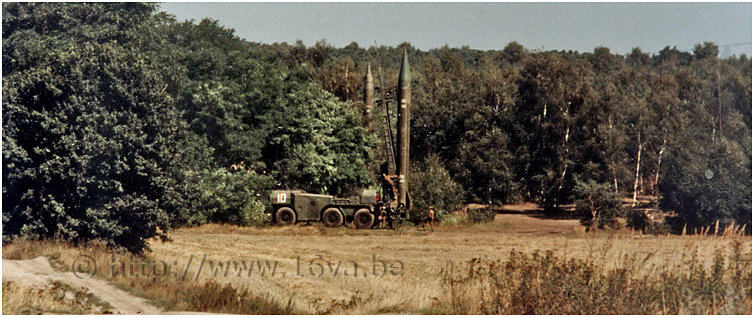Soviet Airfield Security
United States Military Liaison Mission Air Team reconnaissance tour personnel proudly strived to avoid being detained while collecting information in the former Soviet Zone of Occupation. Although there was no firm definition of what exactly constituted a detention, my personal definition was this: a reconnaissance tour was considered to have been detained only if a representative of the local komendatura (military police office) came to the scene and an official akt (statement) was prepared. Tour personnel always refused to sign such a document. The severity of a detention or an incident dictated whether or not the reconnaissance tour should be aborted and the team immediately report back to West Berlin. This was a judgment call on the part of the reconnaissance tour officer. For instance, getting caught while observing a vehicle column and having an akt prepared would not be grounds to end the tour. If any shooting had occurred, the tour team was expected to return to West Berlin immediately and file a report. In any event, a detention might be reported up the Soviet chain of command. The Chief of Mission theoretically could be summoned to the Soviet External Relations Branch (SERB) in Potsdam to be chastised for the dastardly deeds of his subordinates. A reconnaissance tour officer had to decide on the spot whether to return to Potsdam and report an incident or detention, or not. It certainly would not be a good idea to leave the Chief of Mission unaware of an impending protest and have him blind-sided by the Soviet authorities...
Falkenberg Soviet Airfield Area Incident
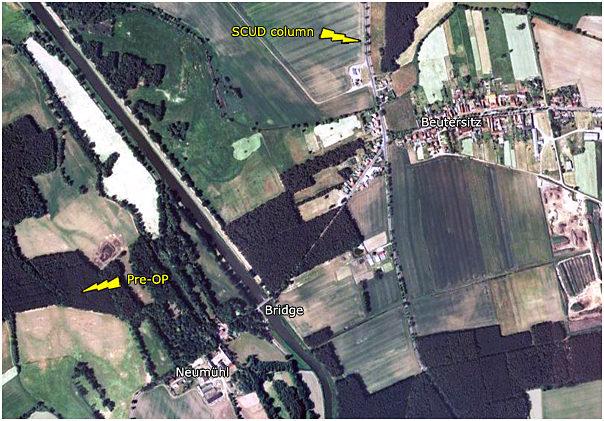 Captain Larry Patterson was traveling with Master Sergeant Konrad Spitzenberger and me in the fall of 1973 to cover flying activity
at Falkenberg Soviet Airfield, where FLOGGER B (MiG-23M) fighter-interceptor aircraft recently had been introduced (see the previous page
describing our coverage of FLOGGER activity there). The intelligence community still needed technical-quality photography of this bird
and we hoped to obtain just that.
What happened to us on that tour taught each of us a very good lesson - never use your sleeping location as a preliminary observation point (pre-OP)!
We had chosen a sleeping location south of Ubigau near the tiny village of Neumühl. This put us about 5 miles due east of the end of the
Falkenberg runway, close enough to the airfield to allow us to hear any activity that might transpire. We were in mixed woods, meaning
there were short fir trees and full-growth forest mixed together. We believed we had entered the area unobserved, and perhaps we had.
However, the local forstmeister (forest ranger) always kept abreast of what was going on in his area of responsibility and they were known to
carefully check the forest trails for telltale signs of visitors. After all, we did not use either Soviet or East German tires on our mission
vehicles so Western tread designs were very distinct. This especially was true of the wide all-weather tires USMLM used on its vehicles.
Regardless of the reason, someone had found out where we were and the bad guys had mounted a detention operation against us.
Captain Larry Patterson was traveling with Master Sergeant Konrad Spitzenberger and me in the fall of 1973 to cover flying activity
at Falkenberg Soviet Airfield, where FLOGGER B (MiG-23M) fighter-interceptor aircraft recently had been introduced (see the previous page
describing our coverage of FLOGGER activity there). The intelligence community still needed technical-quality photography of this bird
and we hoped to obtain just that.
What happened to us on that tour taught each of us a very good lesson - never use your sleeping location as a preliminary observation point (pre-OP)!
We had chosen a sleeping location south of Ubigau near the tiny village of Neumühl. This put us about 5 miles due east of the end of the
Falkenberg runway, close enough to the airfield to allow us to hear any activity that might transpire. We were in mixed woods, meaning
there were short fir trees and full-growth forest mixed together. We believed we had entered the area unobserved, and perhaps we had.
However, the local forstmeister (forest ranger) always kept abreast of what was going on in his area of responsibility and they were known to
carefully check the forest trails for telltale signs of visitors. After all, we did not use either Soviet or East German tires on our mission
vehicles so Western tread designs were very distinct. This especially was true of the wide all-weather tires USMLM used on its vehicles.
Regardless of the reason, someone had found out where we were and the bad guys had mounted a detention operation against us.
 Le capitaine Larry Patterson en attente d'action. Une bâche avait été posée sur le pare-brise de cette Ford Custom 500 - une voiture utilisée
au début des années 70 - afin d'éviter les reflets
du soleil qui auraient pu trahir la présence du véhicule. © USMLM.
Le capitaine Larry Patterson en attente d'action. Une bâche avait été posée sur le pare-brise de cette Ford Custom 500 - une voiture utilisée
au début des années 70 - afin d'éviter les reflets
du soleil qui auraient pu trahir la présence du véhicule. © USMLM.
Captain Larry Patterson waiting for action. A tarp had been placed on the windshield of this Ford Custom 500 - a car that was used during the early
1970s - in order to avoid sun reflections that could betray the presence of the vehicle. © USMLM.
 Bill Burhans en train de noter les numéros de code des avions lors d'une journée de vol sur un aérodrome soviétique de RDA. © USMLM.
Bill Burhans en train de noter les numéros de code des avions lors d'une journée de vol sur un aérodrome soviétique de RDA. © USMLM.
Bill Burhans seen logging aircraft bort numbers while monitoring a flying program on a Soviet airfield in the GDR. © USMLM.
Each Soviet airfield maintained a rapid-reaction force tasked to respond to notifications of the presence of allied foreign military
liaison mission reconnaissance tour teams and to detain such interlopers. Such a force had been marshaled from Falkenberg on this occasion,
as we were to find out.
The three of us had slept well and, after breakfast, we set up to wait for flying activity. We used green Army OD blankets on the vehicle
to cover the shiny areas and were basically just sitting there quietly in the woods. Finally, we heard the sound of an aircraft passing overhead.
Then another plane flew over. After three or four aircraft had been active, we figured it was time to head for an observation point from which we
could observe and photograph the flying activity. We decided it was time to pack things up and to move out.
Larry happened to notice movement in the trees about 35-40 yards away. He began to walk toward the individual, who could just barely be seen peeking
out from behind a tree. After walking several yards toward this Stasi nark, Larry suddenly stopped in his tracks, and then rushed back to the car.
The fact the nark did not run away, as usually was the case once we had discovered them, was an ominous sign. Larry shouted to us to pack up quickly
and prepare to move out. We did just that.
The car was in a small opening in the tall trees. In front of us were short fir trees and there was a trail that ran to the right and left in front of
us between the two stands of trees. We were at a point where the trail to the left went down a slight incline to a main trail, while that to the right
was level and ran out to another main trail. We had selected this place for just that reason; our normal procedure was to ensure that we always had
at least two ways to escape from an OP in the event of necessity.
Spitz started the vehicle and moved a few yards forward to the trail, where he turned left and started down the incline. Right in front of use was a
large ZIL-131 cargo truck coming up the incline. Instead of ramming into us, the truck driver hit his brakes. He apparently failed to push in the clutch
and, in so doing, his truck stalled.
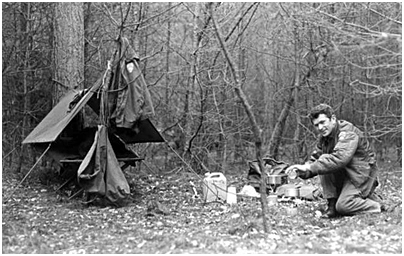 Le segent-chef Konrad Spitzenberger prépare le repas du soir près de sa couchette pour la nuit. © USMLM.
Le segent-chef Konrad Spitzenberger prépare le repas du soir près de sa couchette pour la nuit. © USMLM.
Master Sergeant Konrad Spitzenberger prepares the evening meal near his army cot for the night. © USMLM.
Without a second's hesitation, Spitz put our Mercedes 350SE four-door sedan into reverse and hightailed it in the
opposite direction. As we reached the original point where we had turned onto that trail, the fir trees erupted with Soviet military, led by an officer
brandishing a pistol. All had the blue lapels on their uniforms that identified them as being members of the Military Air Forces.
Nothing, not even these people who had poured out of the woods, hindered Spitz whatsoever. Amazing as it may now seem (and how fortunate it turned out to be),
Spitz had been able to raise the window in the door on his side of the car while speeding backwards up that trail. A Soviet soldier used his AK-47 automatic
weapon as a baseball bat and tried to hit Spitz in the head. Glass flew everywhere, but Spitz did not stop for anything. Had the window not been there to
absorb this heavy blow, I am convinced Spitz would have been either knocked unconscious, or perhaps killed...
We all thought we certainly were about to be detained. Surely the Soviets had another large truck on the other trail, our only other way out. Much to our
surprise, the only thing in our way was the crowd of soldiers that had come out of the woods. Spitz simply plowed on through them in reverse as he headed
out to the main trail. The troops bailed out back into the woods to avoid being hit. We took off out of those woods as fast as we could, amazed by our good fortune.
It is clear the fast reaction team was from Falkenberg Airfield and they had used the sound of the aircraft and our resultant diverted attention to cover
their movements as they crept up closer to us. They were in no hurry and did not give themselves away. Their team surprised us completely. However, I will
never understand why they left an escape route open to us...
We dashed through the woods out into the open and onto the road that went eastwards into Neumühl. We quickly drove through this little village to the bridge
that crossed the Schwarze Elster River, continuing on to the town of Beutersitz. Here, we turned left (north) onto Route 101, the main north-south road between
Bad Elsterwerda and Jüterbog and urgently began to look for a good place to hide.
Each of us was quite shaken up. The adrenaline level was sky high! We were picking tiny pieces of glass from our clothes and from all around us.
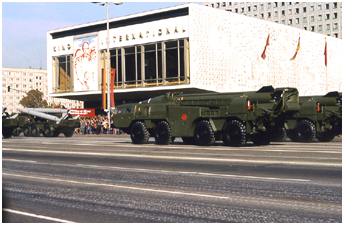
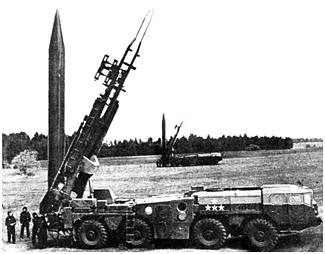 Mise en oeuvre de missiles R-17 (SS-1C "SCUD-B") de la 112ème Brigade de Missiles stationnée à Henzrode. © DR.
Mise en oeuvre de missiles R-17 (SS-1C "SCUD-B") de la 112ème Brigade de Missiles stationnée à Henzrode. © DR.
R-17 missiles (SS-1C "SCUD-B") of the 112th Missile Brigade stationed at Henzrode, deployed on a training range. © DR.
As we began to quiet down and discuss what we just had been through, we ran smack dab into a very sensitive target! We encountered a SCUD B tactical surface-to-surface missile
unit on a road march south. We thought for sure that we were in the soup this time! Here we were just having escaped one detention, and with a window broken out
of the car to boot! Had this group, a type of unit known to be highly security conscious and quick to react, detained us, there is little doubt they would have
gotten into the vehicle and would have confiscated all our equipment.
Luck again was with us, the second time that morning. There were, of course, no communications between the people in the SCUD unit and the airfield quick-reaction
team troops, so we were not vulnerable from that point of view. Besides, the SCUD group paid absolutely no attention whatsoever to us.
It is entirely possible that they did not even recognize us for what we were since such units seldom came out of the permanently restricted areas and allied
foreign liaison mission reconnaissance tours very seldom were inside these closed areas. This unit had somewhere to go and were on a fixed schedule, so brooked
no interference. We unobtrusively took down the vehicle registration numbers and photographed the signature vehicles. At our first opportunity, we took a side
road into the woods. We worked our way into some heavy cover and stopped for a while to try to get our vital signs back down to normal and to clean up the
vehicle somewhat. We subsequently were able to continue the reconnaissance tour and covered our other assigned targets without further difficulties.
 |
Falkenberg Adventures < Part 1 |
 |
Plan du site - Sitemap |  |

